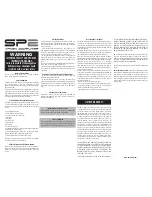
79
Setting the Swell/Dip Trigger Thresholds in PSM
To check or set the swell/dip trigger thresholds, at the main menu click on Data Setup. At the bottom of
the screen is the
“Triggering for Swells, Dips, Transients” section. The upper area of this section is for
setting which signals to trigger on and for deciding how many signals to capture when a trigger occurs.
The bottom section is for setting the actual trigger thresholds.
If you wish to trigger on one or more
voltages, check in
the “Voltage to
trigger on” section to make sure that
the voltage signals you wish to
trigger on are checked. Clicking on
the box in front of the signal name
results in a ‘checkmark’ being
displayed in the box, indicating that the triggers apply to that signal. Clicking on a box that already has
a checkmark in it, erases the checkmark, indicating that the triggers do not apply t that signal.
Similarly, if you wish to trigger on one or more currents, check the “Current to trigger on” section and
make sure that the current signals you wish to trigger on are checked.
Next,
in the “Trigger Thresholds” section, enter the swell and dip threshold values you wish to trigger
on. A swell occurs when the RMS value of ½ cycle rises above this trigger level on any signals that
have checkmarks preceding them. For
instance if the “Current Swells” threshold is set for 15 ARMS
and I
1
has a checkmark in front of it and the RMS value of any ½ cycle of I
1
rises to 15.1 ARMS or
higher, then the threshold will have been passed, triggering will occur, and the event will be considered
to have started. When the current in this example falls to slightly less than 15 ARMS, the swell will
have ended, unless it rises above the trigger threshold again within 1 second. In that case, the swell is
considered to be continuing still.
A dip occurs when the RMS value of ½ cycle falls below the trigger level on any signals that have
checkmarks preceding them. For instance if the “Voltage Dips” threshold is set for 475 VRMS ph-ph
and V
12
has a checkmark in front of it and the RMS value of any ½ cycle of V
12
falls to 474.9 VRMS ph-
ph or lower, then the threshold will have been passed and triggering will have started. When the
voltage in this example rises to slightly more than 475 VRMS ph-ph, the dip will have ended, unless it
falls below the trigger threshold again within 1 second. In that case, the dip is considered to be
continuing.
If you wish to capture inrush current graphs, enter a swell current threshold slightly above the normal
running level for current. This will cause a swell event to be triggered when the inrush starts and it
ensures that the event is considered ended when the normal running state is reached.
It should be noted that you generally will not want to select the neutral current, I
N
, if you are also
triggering on other currents. This is because the neutral current is typically much smaller than the other
phase currents and needs to have different trigger thresholds.
When all the trigger levels are set correctly, you may save the data setup to a file or to a connected
ATPOL II.
Содержание ATPOL II
Страница 109: ...109...
















































